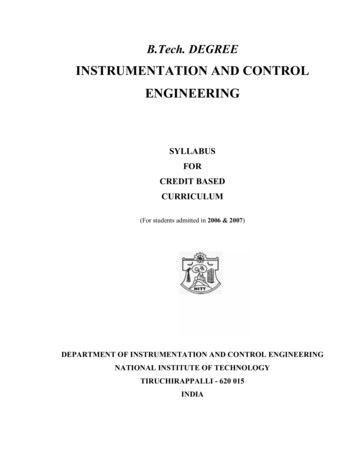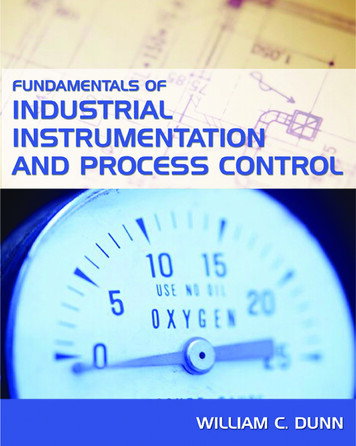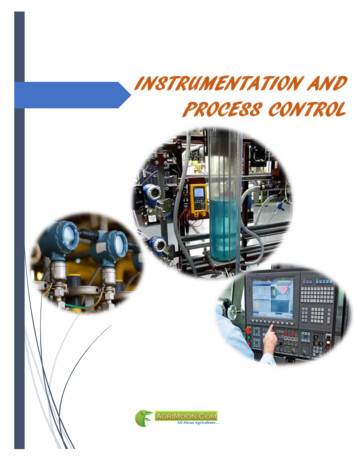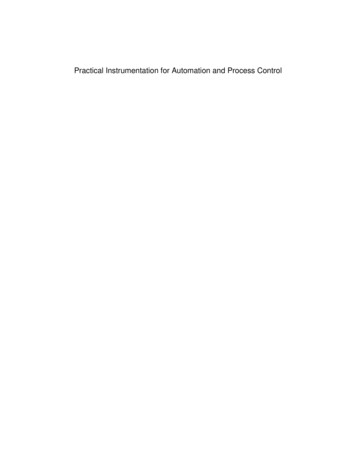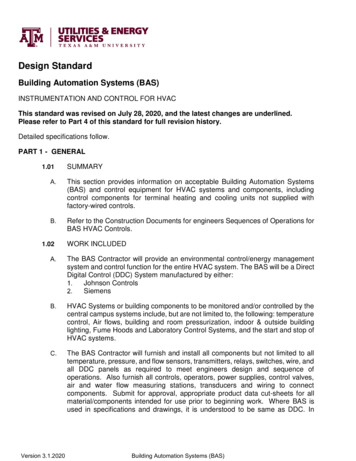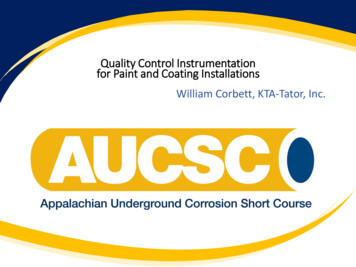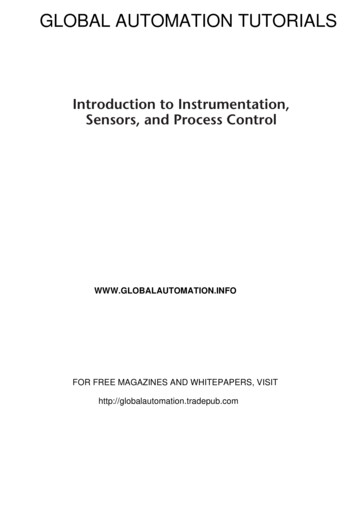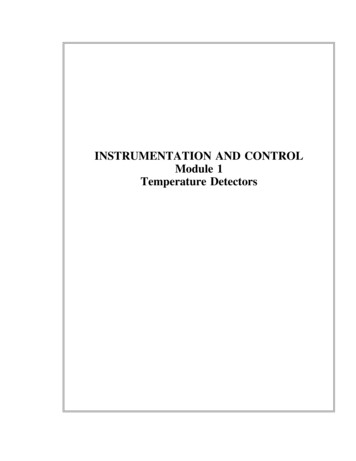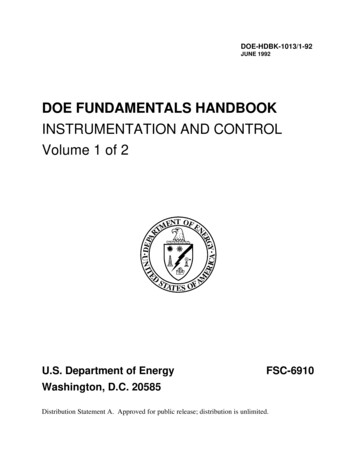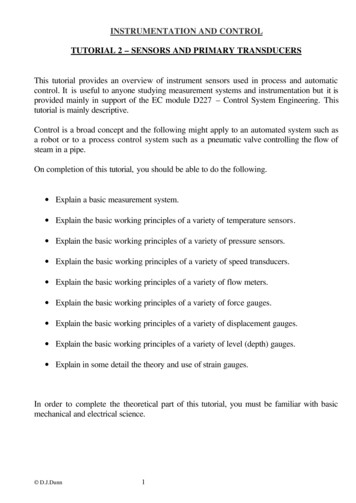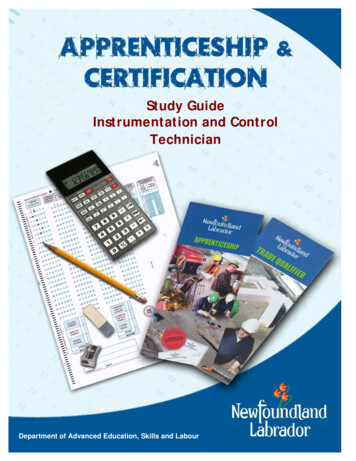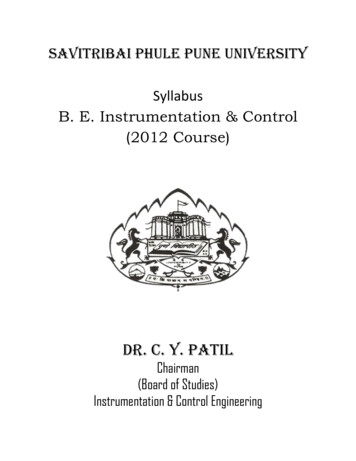
Transcription
SAVITRIBAI PHULE PUNE UNIVERSITYSyllabusB. E. Instrumentation & Control(2012 Course)DR. C. Y. PATILChairman(Board of Studies)Instrumentation & Control Engineering
Savitribai Phule Pune UniversitySyllabus for B. E. Instrumentation and Control - 2012 courseSEMESTER‐ ICODESUBJECTProcessInstrumentation‐ IProject Engineering &406262Management406261TEACHINGEXAMINATION SCHEMESCHEMETH PR In semester End SemesterPR TW ORassessment 6263 Digital Control423070‐25‐125406264 Elective‐ I323070‐‐50150406265 Elective‐ II3‐3070‐‐‐100406266 Project Stage‐ I‐2‐‐50‐501810150350Total‐50100 100750SEMESTER‐ IICODE406267SUBJECTProcessInstrumentation‐ IITEACHINGEXAMINATION SCHEMESCHEMETH PR In semester End SemesterPR TW ORassessment AssessmentTotal423070‐‐50150406268 Industrial Automation423070‐‐50150406269 Elective‐ III423070‐‐50150406270 Elective‐ IV4‐3070‐‐‐100406271 Project Work‐6‐‐‐100 50150406272 Industrial Visit‐‐‐‐‐50501612120280‐150 200TotalSyllabus of B. E. Instrumentation 2012 course‐Page 1750
Elective‐ I (406264)Elective‐ II (406265)Advanced Bio‐MedicalInstrumentationOpto‐ ElectronicsInstrumentationDigital ImageProcessingBuildingAutomation‐ IEnvironmentalInstrumentationBuilding Automation‐ II Instrumentation inAgriculture and FoodProcessingAdvanced ControlSystemsRobotics &AutomationProcess Modelling &OptimizationNeural Network andFuzzy Logic ControlAdvanced SensorsSensor ationAdvanced DigitalSignal ProcessingFault Detection andDiagnosisComputer Techniquesand ApplicationsOpen ElectiveSyllabus of B. E. Instrumentation 2012 courseElective‐ III (406269)Elective‐ IV (406270)Smart Material andSystemsPage 2
SEMESTER- I
406261: Process Instrumentation‐ ITeaching Scheme:Lectures: 4 Hrs/ WeekPractical: 2 Hrs/ WeekExamination Scheme:Paper: (30 70) 100 MarksIn semester Assessment: 30 MarksEnd Semester Assessment: 70 Marks.Practical: 50 MarksPrerequisite: Sensors and Transducers, Automatic control systems, Control systemcomponent and Process loop controlUnit‐ I : Process CharacteristicsIncentives for process control, Process Variables types and selection criteria,, Processdegree of freedom, Characteristics of physical System: Resistance, Capacitive andCombination of both.Elements of Process Dynamics, Types of processes‐ Dead time, Single /multi‐capacity, self‐Regulating /non self regulating, Interacting / non‐interacting, Linear/non linear, andSelection of control action for them. Study of Liquid Processes, Gas Processes, FlowProcesses, Thermal Processes in respect to above conceptsUnit‐ II : Analysis of Control LoopSteady state gain, Process gain, Valve gain, Process time constant, Variable time Constant,Transmitter gain, Linearising a equal percentage valve, Variable pressure drop. Analysis ofFlow Control, Pressure Control, Liquid level Control, Temperature control, SLPC‐features,faceplate, functions, MLPC‐ features, faceplate, functions, SLPC and MLPC comparison.Scaling: types of scaling, examples of scalingUnit‐ III: Feedback ControlElements of the feedback Loop, Block Diagram, Response to Set‐point changes andDisturbances, PID Controller Algorithms, Control Performance Measures, Selection ofVariables for Control Approach to Process Control. Factors in Controller Tuning,Determining Tuning Constants for Good Control Performance, Correlations for tuningConstants, Fine Tuning of the controller tuning Constants. The performance of feedbackSystems, Practical Application of Feedback Control: Equipment Specification, InputProcessing, Feedback Control Algorithm, Output Processing.Unit‐ IV : MultiLoop & Nonlinear SystemsBasic principles, Design Criteria, Performance, Controller Algorithm and Tuning,Implementation issues of Cascade control, Feed forward control, feedback‐feedforwardcontrol, Ratio control, Selective Control , Split range control. Examples and any specialfeatures of the individual loop and industrial applications.Nonlinear Elements in Loop: Limiters, Dead Zones, Backlash, Dead Band Velocity Limiting,Negative Resistance, Improvement in nonlinear process performance through:Syllabus of B. E. Instrumentation 2012 coursePage 3
Deterministic Control Loop Calculations, Calculations of the measured variable, final controlelement selection, cascade control design, Real time implementation issues.Unit‐ V : Multivariable ControlConcept of Multivariable Control: Interactions and it’s effects, Modelling and transferfunctions, Influence of Interaction o the possibility of feedback control, important effectson Multivariable system behavior Relative Gain Array, effect of Interaction on stability andMultiloop Control system. Multiloop control Performance through: Loop Paring,tuning,Enhancement through Decoupling, Single Loop Enhancements.Unit‐ VI : Process control DesignDefining the problem, measurements, final elements, Process Operability, ControlStructure, Control Algorithm, Control for safety, performance Monitoring. Managing theDesign Process: Sequence of design steps, hierarchy of control structure, processDecomposition, Integrating the control design methods, key guidelines.List of Experiments :Students are expected to perform Minimum 8 Experiments1. Develop a FOPDT/SOPDT model of any process.2. Effect of control actions on system with dead time and integrating systems(UsingMATLAB).3. Study of Flow loop/Study of Level loop.4. Study of Temperature loop.5. Study of Pressure loop.6. Finding best tuning values based on any performance criteria.7. Study of Cascade control loop.8. Study of Ratio control/ Selective control. (any one)9. Study of SLPC for process control.10. Study of non linear control elementsText Books:1. Automatic Process Control: Donald Eckman, Wiley Eastern Limited.2. Process Control‐ Designing processes and Control Systems for DynamicPerformance: Thomas E Marlin, McGraw‐Hill International.3. Instrument Engineers' Handbook : Process control : B.G. Liptak, Chilton.4. Chemical Process Control : George Stephonopolous, PHI.5. Process Control: Modeling, Design and Simulation : B. Wayne Bequette, PHI.6. Process control Systems‐F.G. Shinskey, TMH.References1. Process Instrumentation and control Handbook –Considine.2. Fundamentals of Process Control ‐ Murrill ISA3. Applications concepts of Process control‐ By Murrill ISASyllabus of B. E. Instrumentation 2012 coursePage 4
406262: Project Engineering and ManagementTeaching Scheme:Lectures: 4 Hrs/ WeekPractical: 2 Hrs/ WeekExamination Scheme:Paper: (30 70) 100 MarksIn semester Assessment: 30 MarksEnd Semester Assessment: 70 Marks.Oral: 50 Marks, Term Work: 25 Marks.Unit‐ IConcept study and definition of Project Engineering and Management,Basics of Project Management, Definition and objectives of Project Management, Stages of ProjectManagement, Project Planning Process, Establishing Project organization. Organization Structure,The Project team, Roles and responsibilities of project team members and team leader,Interactions involved in Project and their co‐ordination project statement.Unit‐ IIWork definition: Defining work content, Time Estimation Method, Project Cost Estimation andbudgeting, Project Risk Management, Project scheduling and Planning Tools: Work Breakdownstructure. Program evaluation and review techniques (PERT) and Critical path method (CPM), Lifecycle phases, Statement of work (SOW), Project Specification, milestone scheduling.Project cash flow analysis, Project scheduling with resource Constraints: Resource Leveling andResource Allocation. Time Cost Trade‐off: Crashing Heuristic.Project Implementation: Project Monitoring and Control with PERT/Cost, Computers applicationsin Project Management, Contract Management, Project Procurement Management; Post ProjectAnalysis.Unit‐ IIIProject engineering documents and drawing:P & I diagram based on Process Flow Sheet, P & ID symbols for process loops like temperature,flow, level, pressure, etc. Material balance sheet and Temperature pressure sheet, Methods oftagging and nomenclature scheme based on ANSI / ISA standards.Standards used in instrumentation project: ISA S5.1, S5.3, S5.4, S5.5 and S5.20, ANSI, & NFPA.Instrument index sheet, installation sketches, specification sheets.Collection and study of project engineering documents and software like INTools, MS‐Project,Primavera.Unit‐ IVDetailed Project engineering: Plant layouts and General arrangement drawing (Plans andElevation), Isometric of instrument piping, installation sketches of filed instrument.Cable Engineering (Class of conductors, Types, Specification and Application), Selection of cableswith respect to specific application, Cable identification schemes, Cable trays, Basic Wiring Practice,Syllabus of B. E. Instrumentation 2012 coursePage 5
wire numbering & numbering methods. Failsafe wiring Practice, Hazardous area classifications & itseffect on design, Loop wiring diagrams, BOM and MBOM. Earthling and Grounding for General,Power and Signal.Unit‐ VProcurement activities: Vendor registration, Tendering and bidding process, Bid evaluation,Purchase orders, Pre‐Qualification Evaluation of Vendor, Kick‐off meeting, Vendor documents,drawing and reports as necessary at above activities.Construction activities: Site conditions and planning, Front availability, Installation andcommissioning activities and documents require at this stage. Cold Commissioning and hotcommissioning.Unit‐ VIControl centres and Panels: Types, Design, Inspection and Specification, Control room layout andengineering, Types of operating Stations, Intelligent Operator Interface (IOI). Panel testingProcedure. On site inspection and testing (SAT), Installation sketches, Contracting, ColdCommissioning and hot commissioning, Customer Acceptance Test (CAT), Factory Acceptance Test(FAT), Performance trials and final hand over. Calibration records, Test and inspection reports.List of Experiments :Students are expected to perform Minimum 8 Experiments1. Study of standards and symbols (ANSI / ISA Std.)2. Study of specification sheets.3. Development of Process & Instrument diagram of typical process.4. Development of Loop Wiring diagram.5. Cable scheduling.6. GA and mimic diagram of a control panel.7. Development of Bar charts for certain project.8. Preparation of Inquiry, Quotation, Comparative statement, Purchase orders, SAT, FAT andCAT, Inspection reports for control panel / transmitter/ control valve / recorder.9. Hands on experience for engineering management software such as MS Project,/Primavera/ INTools.Text Books & References:1. Applied instrumentation in process industries by Andrew & Williams (Gulf Publishing).2. Management systems by John Bacon (ISA)3. Process control Instrument Engineers Hand book by Liptak.4. Project Management A System Approach to Planning, Scheduling and Controlling by HaroldKerzner (Van Nostrand Reinhold Publishing)5. Instrument Installation Project Management (ISA).6. successful Instrumentation & Control Systems Design, by Michael D. Whitt (ISA).Syllabus of B. E. Instrumentation 2012 coursePage 6
406263: Digital ControlTeaching Scheme:Lectures: 4 Hrs/ WeekPractical: 2 Hrs/ WeekExamination Scheme:Paper: (30 70) 100 MarksIn semester Assessment: 30 MarksEnd Semester Assessment: 70 Marks.Term Work: 25 MarksUnit‐ IINTRODUCTION TO DISCRETE TIME CONTROL SYSTEMBasic building blocks of Discrete time Control system, Sampling Theorem, Choice of sampling rateand multirate sampling, Z transform and Inverse Z transform for applications for solving differentialequations, Impulse sampling, Effect of data digitization and finite word length, Reconstruction:Data Hold, Mathematical model of zero order holdUnit‐ IIPULSE TRANSFER FUNCTION AND DIGITAL CONTROLLERSThe pulse transfer function, pulse transfer function of Open loop and Closed Loop systems, Pulsetransfer function of Digital PID controller, Velocity & Position forms of Digital PID Controller,Realization of Digital Controllers, Deadbeat response and ringing of poles, Design of DeadbeatController.Unit‐ IIISTABILITY ANALYSIS OF DISCRETE TIME CONTROL SYSTEMStability regions in S‐plane, W‐plane and Z‐plane and mapping between the three planes, Stabilitytests for discrete system, Jury stability criterion, Bilinear transformations, Digital Controller Designusing Analytical Design Method.Unit‐ IVDESIGN OF DISCRETE TIME CONTROL SYSTEM ‐ STATE SPACE APPROACHRelation between State equations and pulse transfer function, Solution of discrete time state spaceequations, Cayley‐Hamilton Theorem, Pulse transfer function matrix, Eigen Values, Eigen Vectorsand Matrix Diagonalization, Discretization of continuous time state space equations, VariousCanonical forms, Similarity transformations.Unit‐ VPOLE PLACEMENT AND OBSERVER DESIGNConcept of Controllability and Observability, Useful transformations in state space analysis anddesign, Pole placement design by state feedback, Stability improvement by state feedback, Stateobservers.Unit‐ VIINSTRODUCTION TO OPTIMAL CONTROLBasics of Optimal Control, Performance Indices, Quadratic Optimal Control and Quadraticperformance index, Optimal state regulator through the matrix riccati equations, Steady StateSyllabus of B. E. Instrumentation 2012 coursePage 7
Quadratic Optimal ControlList of Experiments :Students are expected to perform Minimum 8 Experiments1. Find the Response of the Discrete Time Control System for standard inputs.2. Unit step Response of Discrete Time Control System using Digital PID controller.3. Design of deadbeat controller for Discrete Time Control System.4. Determine effect of sampling period on stability of Discrete Time Control System.5. Design State space model from the given PTF.6. Investigation of the controllability and Observability of a system.7. Design of control system using pole placement technique.8. Design of State observer.9. Design of Discrete Time Control System based on minimization of quadratic performanceindex.10. The solution of steady state quadratic optical control using riccati equation.11. Design of a control system by optimal control.Text Books:1. Discrete Time Control systems by K. Ogata, Prentice Hall, Second Edition,2003.2. Digital Control and State Variable Methods by M. Gopal, Tata McGraw Hill,2003.References:1. Digital control of Dynamic Systems by G.F.Franklin, J.David Powell, Michael Workman 3rdEdition, Addison Wesley, 2000.2. Digital Control Engineering by M. Gopal, Wiley Eastern Ltd, 1989.3. Digital Control by Kannan Moudgalya, John Wiley and Sons, 2007.4. Digital Control by Forsytheand W. and Goodall R.N McMillan,1991.5. Digital Control Systems by Contantine H. Houpis and Gary B. Lamont, Second Edition,McGraw‐Hill International, 2002.Syllabus of B. E. Instrumentation 2012 coursePage 8
406264‐ Elective‐ I: A) Advanced Bio‐ Medical InstrumentationTeaching Scheme:Lectures: 3 Hrs/ WeekPractical: 2 Hrs/ WeekExamination Scheme:Paper: (30 70) 100 MarksIn semester Assessment: 30 MarksEnd Semester Assessment: 70 Marks.Oral: 50 MarksCourse Objective (COs): To understand the advanced biomedical nstruments used in hospitals. To review the basic concept of medical Imaging systems. To understand the concept of various biomedical instruments and technologies.Course Outcomes (COCs):a. Ability to design, calibrate and use various biomedical equipments.b. Ability to select appropriate method for the particular applicationsc. Ability to apply concept for appropriate use of various biomedical techniques andInstruments.Unit‐ IClinical Lab Instrumentation:Blood and its composition and function, Auto‐analyzers, Blood Cell Counters, Pulse Oximetry,Introduction to telemetry & TelemedicineUnit‐ IIImaging Systems:X ray properties, Generation of X‐rays, block diagram of X‐ Ray machine, image intensifier,Drawback of x‐ray imaging, CT Scanning, basic CT scanning system, Types of gantries, gray scale[Hounsfield No.], image reconstruction techniques in tomography, image artifactsUnit‐ IIIAdvanced Imaging Systems:Radionuclide Imaging: Positron Emission Tomography, Single Photon Emission ComputedTomography, Ultrasound Imaging: Fundamentals of Acoustic propagation, Ultrasonic transducersand frequencies, A, B, M Scan and Introduction to MRI operating principle.Unit‐ IVLife Saving Devices:Pacemaker, Types of pacemakers: External & Internal, Defibrillators: AC & DC Defibrillator, HeartLung Machine.Diathermy:Electro surgical diathermy (ESU),Short wave, Microwave, Ultrasound diathermySyllabus of B. E. Instrumentation 2012 coursePage 9
Unit‐ VLaser applications in Medicine:Types of Lasers, Properties of Laser, Interaction of Lasers with Tissues ‐Thermal and Non thermal,Basic Endoscopes system & its characteristics, Laser Applications in ophthalmology‐ DiabeticRetinopathy , Glaucoma and Retinal hole and detachment treatment , Dermatology‐ Tattoo, portwine treatmentUnit‐ VIConcept of Rehabilitation Engineering:Orthrotics & Prosthetic devices, overview of various orthrotics & prosthetic devices along with itsmaterials. Wheelchair Types, Materials used in wheelchair,Kidney Instrumentation:Kidney Structure, structure of nephron, Regulation of Water and Electrolyte Balance, ArtificialKidney‐types (Coil type, parallel plate Type), Dialysis System, LithotripsyList of Experiments :Students are expected to perform Minimum 8 Experiments and visit to hospital.1. Clinical Lab Instrumentation: Auto‐analyzer, blood cell counters etc.2. Basic Telemetry system: ECG Telemetry System3. Electrosurgical Unit (Operating Room).4. Imaging Techniques’‐ray and CT scan5. Advanced Imaging Techniques –Ultra sound and Nuclear imaging6. Pacemaker & Defibrillator7. Short Wave Diathermy8. Ophthalmic/ Dermatological LASER treatment9. Basic Endoscope10. Rehabilitation equipments11. Lithotripsy12. Dialyzer machineText Books:1. Medicine and Clinical Engineering By Jacobsons & Webster, PHI2. Introduction To Biomedical Equipment Technology By Carr & Brown3. Biomedical Instrumentation and Measurements By Cromwell, PHI4. Handbook of Biomedical Instrumentation By R. S. Khandpur, TMH5. The Biomedical Engineering Handbook, Bronzino, IEEE Press6. Applied Chemical Engineering Feenberg,7. Principles of Medical Imaging.‐By: K. Kirk Shung, Michael B. Smith, Benjamin Tsui.‐Pub:Academic Press.8. Medical Laser Applications ‐By Carruth9. Medical Lasers & their safe Use ‐ By Sliney & TrokalSyllabus of B. E. Instrumentation 2012 coursePage 10
406264‐ Elective‐ I: B) Building Automation‐ ITeaching Scheme:Lectures: 3 Hrs/ WeekPractical: 2 Hrs/ WeekExamination Scheme:Paper: (30 70) 100 MarksIn semester Assessment: 30 MarksEnd Semester Assessment: 70 Marks.Oral : 50 MarksUnit‐ I:Introduction to intelligent buildings and Building automation systems What is intelligent building? Intelligent architecture and structure Facilities management vs. intelligent buildings Lifecycle of building Evolution of intelligent buildings What is BAS? Different systems in BAS which includes HVAC, security, fire, lightingsystems. Importance of each system in BAS. Process of BAS design, Role of different stakeholders (Architect, contractor,consultant, application engineer and engineer) in BAS system design. Comfort parameters for human being‐ temperature, humidity, flow, pressure, cleanair, Co2%.Unit‐ IIComfort parameters for human being and measurement in BMS system Temperature, Heat, Specific Heat, Sensitive Heat & Latent Heat, Enthalpy, Entropy Heat Transfer ‐ Conduction, Convection, Radiation Working Principle, Characteristics of different types of temperature sensors‐ RTD,Thermister, Thermocouple, Bimetallic strip Humidity, Specific Humidity, Relative Humidity, Due point, Saturation point Dry bulb & Wet bulb temperature, Working principle of Psychrometer Working principle of different types of relative humidity sensors‐ capacitive type.Different types of mounting for humidity sensors in BAS Psychrometric chart‐Introduction to different axis in Psychrometric chart‐ wet bulbtemperature, dry bulb temperature, relative humidity, specific heat, enthalpy, dewpoint. Pressure, Static Pressure, Velocity pressure, Absolute Pressure, Gauge Pressure,Vacuum Pressure, Differential Pressure, Sealed Pressure Working Principal of Different types of Pressure Sensors‐ Diaphragm type,Piezoelectric sensors Different types of mounting for Pressure sensors in duct, rooms and pipes Working of principal and construction of different air flow sensors – Anemometerflow meters, thermal dispersion flow meter, Flow measuring station, measurementof flow using velocity pressure sensorsSyllabus of B. E. Instrumentation 2012 coursePage 11
Working of principal and construction of different water flow sensors – Turbine flowmeters, Magnetic Flow meter, Orifice, Venturi, Pitot tube, Nozzle, Corollis, Ultrasonicflow meterDifferent types of mounting for air & water flow metersMeasurement of CO2 level in airClean air, grade of filtration, ozonisation and UV treatmentOther Parameters affecting building operation‐ Building load for Chilled water andhot water system, Working principal of BTU meter, BTU meter mounting,Unit‐ IIIHVAC Basic Concepts‐ Systems (Air Side)‐ Air handling unit Concept of Air handling unit. Design, working of different components in AHU‐damper, filter, cooling coil, heating coil, fan, heat recovery wheel, humidifier. Working, configuration, characteristics for different types of dampers‐ Parallel blade,opposed blade, round damper. Damper Sizing , damper authority Design and working of different types of AHU with combination of‐ 100% outdoorair, mixed air, constant volume, variable volume, dual duct, single duct. Operation of different modes in AHU‐ humidification, dehumidification, staticpressure control, volume matching, warm up mode, night purge mode, cooling,heating, economiser mode. Heat recovery techniques‐ plate heat exchanger, heat recovery wheel, and glycolheat recovery. Use of different types of AHU for different applications. Tracking of different processes in psychometric chart for 100% outdoor air AHU andmixed air AHU‐ humidification, dehumidification, dry cooling, dry heating.Unit‐ IVHVAC Basic Concepts‐ Systems (Air Side)‐ Terminal Unit Concept of Variable Air Volume (VAV) system‐Design, working, use of different typesof VAV‐ CAV, cooling only, with reheat, series fan powered, parallel fan powered,pressure dependent, supply‐exhaust VAV, and dual duct VAV. Design, working, use of radiation coil, chilled beam, CRAC unit, VRV systems, unitheater, Fan coil unit and unit ventilatorUnit‐ VHVAC Basic Concepts‐ Systems (Plant Side)‐ Chilled water system & Hot water systemChilled Water Systems: Concept of refrigeration cycle. Working, mechanical configuration of different typesof components used in refrigeration cycle‐ evaporator, condenser, compressor,expansion valve. Difference between air cooled chiller and water cooled chiller.Working, mechanical configuration of different types of cooling towers. Concept andworking of Absorption chiller. Concept and working of heat pump.Syllabus of B. E. Instrumentation 2012 coursePage 12
Design, working of different types of chilled water system‐ single chiller system,series chiller system, parallel chiller system. Working of different components ofchilled water system‐ decoupler line, bypass line, primary circuit, secondary circuit,and condenser pumps. Concept of free cooling‐ direct waterside, series waterside,parallel waterside free cooling.Sequencing of chilled water plantHot water systems:Working and design of different types of boilers‐ fire tube, water tube, packagedboiler.Control of boiler‐ 7 element control, fuel‐air ratio control.Working and design of different types of heat exchanger.Concept of geothermal system, Working, design of different types of hot watersystem‐ with boilers, heat exchanger with steam input, heat exchanger with hotwater input, geothermal system, solar system and combination of all listed systems.Sequencing of Boiler PlantUnit‐ VIBAS System Architecture BAS System Hierarchy –Field level components, Direct Digital Control (DDC),Supervisory Controller, Server, Operator Workstation (OWS) Different communication protocol and addressing concepts‐ Open Protocols ‐BACnet, LON, Profibus, Modbus, M‐bus,‐ Proprietary Protocols‐ N2, CBUS, Introduction to wireless – Wireless filed devices, controllers, routers, coordinatorsList of Experiments:1. To study IBMS System2. To study Psychometric chart and various parameters3. To study various comfort parameters for human being temperature, humidity, flow,pressure, clean air, Co2%.4. To study different types of Air Handling Units5. To study various terminal unit systems (CAV, VAV, FCU, UV)6. To study Chilled Water System and loops7. To study Hot Water System and loops8. To study Architecture of BAS system9. To study building loads and BTU meteringText Books & References:1. HVAC Systems Design Handbook, Fifth Edition by Roger W. Haines2. HVAC Fundamentals, volume 1 to 3 by James E. Brumbaugh3. Basics of Air Conditioning by ISHRAE. Indian Society of Heating, Refrigerating & AirConditioning Engineers (product code: B0004 for online shopping)Syllabus of B. E. Instrumentation 2012 coursePage 13
4. All About AHU’s by ISHRAE. Indian Society of Heating, Refrigerating & Air ConditioningEngineers (product code: B0005 for online shopping)5. Chillers Basics by ISHRAE. Indian Society of Heating, Refrigerating & Air ConditioningEngineers (product code: B0009 for online shopping)6. HVAC Handbook Part‐1 by Indian Society of Heating, Refrigerating & Air ConditioningEngineers7. Handbook – Industrial Ventilation Application 2004 by Inidian Society of Heating,Refrigerating & Air Conditioning Engineers8. Fundamentals Of Refigeration by Indian Society of Heating, Refrigerating & Air ConditioningEngineers9. Ventilation Handbook by Indian Society of Heating, Refrigerating & Air ConditioningEngineersSyllabus of B. E. Instrumentation 2012 coursePage 14
406264‐ Elective‐ I: C) Advanced Control SystemTeaching Scheme:Lectures: 3 Hrs/ WeekPractical: 2 Hrs/ WeekExamination Scheme:Paper: (30 70) 100 MarksIn semester Assessment: 30 MarksEnd Semester Assessment: 70 Marks.Oral: 50 MarksUnit‐ INON‐LINEAR SYSTEMSTypes of non‐linearity, typical examples, singular points, Phase plane analysis, Limit cycles,linearization, Describing functions. Need for model reduction, Dominant pole concept. Modelreduction via partial realization. Time moment matching and pade approximation, Hankel normmodel reduction.Unit‐ IISTABILITYStability concepts ‐ Equilibrium points ‐ BIBO and asymptotic stability, Lyapunov Theory, Definitions(Stability and Functions). Direct method of Lyapunov, Application to non‐linear problems. Stabilityanalysis by describing function method –jump resonance. Frequency domain stability criteria,Popov's method and is extensions.Unit‐ IIIMODEL REFERENCE ADAPTIVE CONTROLDifferent configurations and classifications of MRAC ‐ Mathematical description ‐ Direct andindirect model reference adaptive control ‐ MIT rule for continues time MRAC systems ‐Lypunovapproach and hyper stability approach for continuous time and discrete time MRAC systems ‐Multivariable systems ‐ Stability and convergence studies.Unit‐ IVSELF TUNING REGULATORSDifferent approaches to self‐tuning ‐ Recursive parameter estimation Implicit and explicit STR ‐LQGself‐tuning ‐ Convergence analysis Minimum variance and pole assignment approaches tomultivariable self tuning regulators.Unit‐ VRECENT TRENDS AND APPLICATIONS OF ADAPTIVE CONTROLRecent trends in self‐tuning Robustness studies multivariable system. Model updating. General‐purpose adaptive regulator. Application to Process control components and systems. IndustrialApplications.Syllabus of B. E. Instrumentation 2012 coursePage 15
Unit‐ VIOPTIMAL CONTROLProblem formulation, necessary conditions of optimality, state regulator problem. Matrix Riccatiequation, infinite time regulator problem, output regulator and tracking problems. Pontryagin‟sminimum principles, time, and optimal control problem. Dynamic programming. Linear QuadraticRegulator, model matching based on Linear Quadratic optimal regulator. Observer design, Linearoptimal filter.List of Experiments :Students are expected to perform Minimum 8 Experiments .1. Analysis of first order/second order non‐linear system.2. Effect of Dominant pole and Critical pole on system performance.3. Stability analysis of first order/ second order system by describing function method.4. Obtain the stability of a system by Frequency domain criteria.5. Study of Direct/indirect model reference adaptive control system.6. Study of multivariable self‐tuning regulators.7. Analysis of Multivariable systems using step input8. Any one Industrial Application of model reference control‐a Survey.9. Design of state observer10. Design of linear filter.Text Books & References:1. Chalam, V.V., "Adaptive Control Systems", Techniques & Applications, Marcel Dekker, Inc.NY and Basel. 1987.2. Eveleigh, V.W., "Adaptive Control and Optimisation Techniques". McGraw‐Hill, 1967.3. Narendra and Annasamy, "Stable Adaptive Control Systems", Prentice Hall, 1989.4. Astry, S. and Bodson, M., "Adaptive Control", Prentice Hall,1989.5. M. Vidyasagar, "Nonlinear Systems Analysis", 2nd Ed., Prentice Hall, 1993.6. Hassan K. Khalil, "Nonlinear Systems", Third Edition, Prentice Hall, 2002.7. William S. Levine (Editor), "The Control Handbook(Electrical Engineering Handbook Series)",CRC Press, March 1996.8. Nagrath I.J., and Gopal, M., "Control system Engineering" Wiley Eastern Reprint 1995.9. Kirk D.E., "Optimal control theory‐an introduction", Prentice Hall, N.J. 1970.10. Gopal. M., "Modern control system Theory", Wiley Eastern Ltd., 2nd Edition Reprint 1995.11. Graham C., Goodwill, S. F. Graebe and M. E. Salgado,"Control12. System Design" Prentice Hall India, New Delhi, 2002.Syllabus of B. E. Instrumentation 2012 coursePage 16
406264‐ Elective‐ I: D) Advanced SensorsTeaching Scheme:Lectures:
1. Applied instrumentation in process industries by Andrew & Williams (Gulf Publishing). 2. Management systems by John Bacon (ISA) 3. Process control Instrument Engineers Hand book
